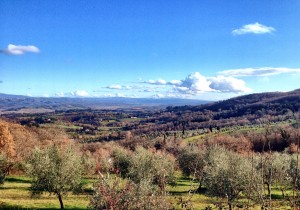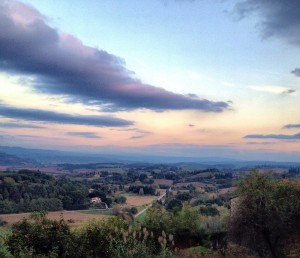Today my day was marred by clouds of heavy doubt about my writing and my painting as well as troublesome and pesky questions about my future. To shake it off I decided to take a walk to Sarteano, a town about 5K uphill from Cetona.
A little medieval hill town much like Cetona but with a big camping clientele, far more sprawl, and a more industrious, less insular population, Sarteano has long been home to many friends and (ex)-boyfriends of mine, and indeed there were months in my teens where I spent more awake time in Sarteano than in Cetona. The two towns have a long history of acerbic rivalry, and up through our adolescence, various groups of guys from each of the towns would fight each other over girlfriends and other matters like they were stuck in the Dark Ages. This used to happen particularly at night and particularly in dancing venues like La Bussola, in Chianciano, where we went dancing on weekends. They would line up against opposing walls, staring at each other, and something would spark, like, who threw a cigarette butt my way, or who looked at me cross. Or someone would walk straight up to someone’s face and punch him, accusing him of something lame like looking at him wrong. M’ha guardato male. Che cazzo vole? He looked at me wrong. What the fuck does he want? That would get them going, maybe starting with two, then more would join the fray and finally it would be a huge pile of guys punching on each other while we girls ran off and eventually home. Yes, much to my embarrassment, some of those people I dated, and much like me, I am sure they have changed.
In any case, the road to Sarteano is well-travelled for me, though strangely I have not been there since I have been back on this trip, in part, I guess, because I am on foot. Today I decided to make good on that.
The countryside between Cetona and Sarteano is some of the most beautiful in the area, an expanse of terraces of moss green grass and olive trees that opens wider and wider the farther up you climb. The road consists of a hairpin curve after another, and as you turn them one at a time you look back behind you to see Cetona grow smaller and smaller and the countryside in between more and more verdant and gorgeous.
On my way up I passed several houses that were playgrounds to me when I was little and homes to good friends of my parents. My friends Flavia and Arabella lived with their parents, Anna and Decimo, on the bottom floor of a big villa owned by a British colonel. Story goes that Decimo met the Colonel, whose name now escapes me, in Rome, when he was a starving little boy, at Liberation, after WWII. The Colonel rescued him from poverty and Decimo went on to work for him, When we met them he was caretaker of his property, together with two Malaysians who mostly cooked for him. I think the Colonel had met them in Malaysia and brought them back with him to England. In any case, Flavia, Arabella, and I spent years’ worth of afternoons playing together on the Colonel’s property, having fun, eating dinners of pasta malesiana together with our parents, and growing, slowly. The Colonel is now dead, and I peered through the edges of the imposing gate that now protects his old home—I don’t know who the owners are—trying to revive an old memory of the house; then I walked to the gate of a house just slightly uphill that belonged to the Colonel’s sister, Nika, and her husband, Sir Jack. Nika and Jack were some of my parents’ best friends—they spent summers in Cetona and holidays, then finally retired there. And like so many others, are now gone. I am constantly reminded these days, as I have been through the years, but particularly now, of how much I miss the friends of my parents, some of whom grew to be closer to me in time than to them. I miss them all very much, and more pointedly here, their ghosts alive and calling and waving from these hills and houses.
On my way up to the road to Sarteano I also passed several old abandoned farmhouses, a few right off the road, a few others a little way off amidst overgrown and abandoned fields. I always find myself following the little roads with my eyes to see the old houses and to imagine the possibilities—to dream, to imagine what might be, what I would do with them. It is my private yarn to do so ever since my parents sold our house in Cetona in the early nineties, a victim of divorce. It is accurate to say that it was the most devastating loss of my life, the most heartbreaking event. The first summer I returned home to this town where I actually no longer had a home, at the age of 26, I was sick with crazy pain, as if I had been yanked up by the roots or by my umbilical cord and laid out naked on the pavement in front of a door that I could no longer unlock. It took me years to recover, if I have, and I will always, I guess, dream of having a home, a house of mine, here, though I realize that certainly nothing would ever be the same about that, either. So I look, I imagine, then I go on.
Right before reaching the town of Sarteano, the road levels off onto a straight stretch that has become the Sarteano Auto Mile. I turned around and headed back to Cetona the way I came, looking down, as I walked, onto Cetona and the valley, now in a warm afternoon light. On my way I was lucky to pass Il Vallone as someone, a caretaker I guess, was coming out of the gate in a car. The Vallone is a stunning villa the color of the purest golden ochre that sits perched on a clearing overlooking Cetona and, below, the valley all the way to the autostrada and beyond. Its position gives it an unhindered view of the countryside and, conversely, gives travelers an unimpeded view of the house, which in late afternoon catches the glorious golden sunlight transforming it into a burst of flaming yellow atop cascading emerald green terraces. In the afternoon the house can be seen for miles. When I was growing up the Vallone belonged to a gay couple (which at the time was somewhat of a deal but not much) who were in my parents’ larger social circle, but I have not been on the property in years, and now that I paint I wanted to see the house’s color up-close in the afternoon light. As the caretaker or maid pulled away in her car, I approached to look down the driveway and the gate stayed open. Wondering whether I would get in trouble, I ventured down the driveway and when I got to the house I called out to see if anyone was there. A caretaker, a man, came out of a shed and asked if he knew me. I explained that I wanted to take a picture of the house, and he was delighted. He told me what had happened to the house in the intervening years—he has worked there for nearly twenty—down to today; the current owner, an elderly British woman who is recently widowed, wants to sell it again. The house badly needs a coat of paint, and new shutters. He walked me to the gate as the sun reached its lowest point before tucking behind Monte Cetona, and we stood for a minute in the warm sunlight. The house was like an apricot on fire, and the green grass like sparkling emeralds.
It was the kind of sensory joy that can uplift even the most troubled, and certainly can suffice to disperse existential questions the answers to which we simply do not have. Sometimes I don’t know is good enough.
Sybil Fix©2014


